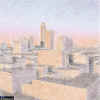|
David Em's Page PART TWO | |
VIEW
I |
 Previous David Em page click HERE Note: The page design comes from Front Page and is not David's responsibility. And as usual, ================ It's Pournelle's Fault ================
DAVID EM’S MULTIMEDIA LAB PRODUCTS DISCUSSED: Informatix Piranesi Kinetix Viz 2 As often happens with computer software, it don’t rain but it pours. In my meanderings about the Web, I came across a rendering application called Piranesi put out by and English company called Informatix (http://www.informatix.co.uk/galleryp.htm). The program is named after the 18th century Italian artist known for his prints of fantastic -- in every sense of the word -- architectural structures. Piranesi is a conceptual precursor of MC Escher, and I’ve no doubt he would have taken to today’s 3D imaging technology like a duck to water. The images on the Informatix site looked promising, so I contacted them and told them what I was up to. A few days later, I had Piranesi installed and running on our Intergraph TDZ 2000. I’ll cut straight to the chase: for still images, Piranesi works wonders. It was obviously written by people who understand architecture and painting from the inside out, not, as all too often happens with imaging programs, the other way around. PIRANESI Piranesi uses a file format called EPix that is an extension of the TIFF format. Informatix has written a 3D MAX EPix exporter (one reason I’m writing about 3D MAX as much as I am lately, is that everyone and their brother is writing programs that connect to it in one way or another), which allows you to save Max renderings as EPix files. Imported into Piranesi, these 2 3/4 D images remember the Z depth information for every pixel, allowing you to use distance fog effects. You can also move cutouts of plants and people in front of and behind every 3D object in your 2D scene. Piranesi provides a number of brushes and pressure-sensitive painting effects. The EPix format saves the original state of your image in a separate layer, so that you can work on top of it without damaging it. By clearing the image on the top layer, and then "painting down"to the original version, it’s possible to create effects that combine line art, watercolor, and a variety of texture effects. A lot of Piranesi’s power lies in the fact that it doesn’t try to do too much, providing just the right balance of elements to accomplish the task of creating a lush image that is partly computer generated and partly hand done, combining the best of both worlds. You might be able to use a program like MetaCreations Painter 5 to achieve most of the same looks, but because Piranesi is so focused on trying to do one specific thing well, it comes off as a winner. It’s also possible to learn the program in a single sitting with the well-written manual. Be forewarned, however that you’ll need a good amount of screen real estate to keep track of all the elements. VIZ 2 Just when I thought it was safe to come up for air, yet another architectural rendering program has hit the market, VIZ 2 from Kinetix. I haven’t had time to do much with it yet, but VIZ clearly is designed with architects and interior designers in mind. To see some examples of VIZ projects, stop by the Kinetix site at www.ktx.com. These are mostly photorealistic renderings composited with scenery and photographic backgrounds, and they look great. I’ll have more to say about VIZ and its big brother 3D MAX 2.5 over the next couple of months, after I’ve had a chance to play with them. NEXT: 3D Shape of Things to Come
PHOTOSHOP 5 Adobe’s Photoshop 5 is on the shelves finally. I’ve barely had time to take a look at it yet, but I have had a chance to work with its new "sticky" lasso tool. I used the new lasso to select and mask a picture of my son Griffin in a very low resolution JPEG file, and it worked fine. This would have been a nightmare to do with the old lasso. The program’s performance with large picture files is improved significantly in Version 5. Version 4.01 took care of the dreadful memory leak problems that were capable of bluescreeening NT 4 in version 4.0, but the program still crashed with a multilayered 145 MB image I was working on to the point that I gave up trying to finish it. I gave it another whirl with version 5, and while pushing that many pixels around is still a good bit slower than I’d like even with today’s fastest processors, the program didn’t crash once. This version must have better multithreading as well; I don’t think the improved filter speeds I’m seeing are a result of my imagination. Oh yes. I also took a look at Photoshop’s new Text tool, and it is light years beyond the old implementation. Besides having more control over the text itself, the great leap forward is the fact that the text you type in the popup text panel now appears in place on your screen, complete with color and whatever formatting you’ve attached to it. I never realized how much time I spend typing and pasting and retyping and repasting text over and over that isn’t quite right. What used to take me a good ten minutes now happens in less than a minute. I could get used to this. There are a number of other new features I’ll talk about after I’ve had some time to work with them, but the most important one is multiple undos, something I’ve been clamoring about for years. Up to now, you got exactly one. But to their credit, this time Adobe has done it right: this is clearly how God intended undos to be. Not only can you undo yourself right back to the beginning of your picture, Photoshop keeps a history of every change you make to your image on tap at all times. Using a popup history palette, you can click to go back and forth to any stage of your image. It’s not only liberating, it’s fun. Graphics developers went nuts releasing new software last month, by the way. Besides Photoshop 5, Adobe released their Premiere 5 video editing software and Image Ready, a Web imaging tool. Macromedia released Flash 3, an animation tool, FireWorks, a Web art program, and they updated their multimedia flagship, Director, from version 6 to 6.5. Then Discreet Logic released Paint* and Effect*, a set of powerful video post-production tools.
There are others, too. With SIGGRAPH in Orlando only two weeks away, this Summer’s wave of Graphics hardware and software releases looks like it’s turning into a tsunami.
|


